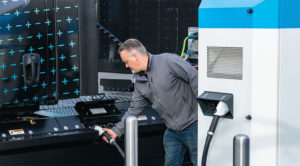by
FOR YEARS, THE discussion about electric commercial trucks was largely just that – a discussion. More conceptual than practical. Today, however, the electric market has come a long way. While still facing obstacles to widespread use on long routes, industry experts say electric is clearly finding its footing.
“The market for electric commercial vehicles is no longer an abstraction or hypothetical,” said Rakesh Aneja, chief of eMobility, Daimler Truck North America (DTNA). “It’s here.”

As battery electric vehicles increasingly become commonplace in the passenger vehicle market, Andy Zehnder, director of fleet sales – advanced technologies and strategic accounts, Kenworth Truck Company, said progress is pushing the commercial truck market forward, too.
“EVs in commercial transportation are benefiting from technological maturity, increasing fuel costs, higher driver turnover and consumer demand for the transportation industry to adopt more sustainability measures,” Zehnder said. “We are now at the forefront of a major shift in the industry to zero-emissions vehicles.”
MAKING INROADS
Aneja said the electric truck market today “is a fraction of what it will become.”
“The trucking industry – from OEMs (original equipment manufacturers) to fuel providers to fleets – has accepted that reality and is investing accordingly,” Aneja said. “Real-world testing has proven the suitability of electric trucks for many applications. And state and federal regulations will continue to apply pressure to accelerate adoption while governments make their own investments in infrastructure.”
Aneja noted that Daimler recently launched and began pre-series production of the new battery electric Freightliner eCascadia, a battery electric truck that provides a typical range of 230 miles (depending on vehicle configurations). Aneja said the eCascadia is particularly suited for short-haul routes that allow for depot-based charging, such as last-mile logistics, local and regional distribution, drayage and warehouse-to-warehouse applications.
Ryan Clayton, regional sales manager for Vanguard Truck Center of Atlanta, said electromobility is being used with increasing regularity for local distribution and regional distribution, and Zehnder said “battery and motor technology is now mature enough where it makes sense for use in the more demanding medium- and heavy-duty markets.”
Zehnder said many fleets are finding that “EVs work extremely well in specific routes and shorter haul applications. Since manufacturers typically supply a wide range of vehicles to customers in varied applications, OEMs are investing significantly in the design and production of EVs, with initial focus on specific applications such as medium-duty and drayage short haul. As technology progresses and more components are available, OEMs will expand production to other types of models.”
Zehnder said electric’s benefits extend to many stakeholders in the trucking industry. A sometimes-overlooked demographic is the driver.
“Drivers will find that EVs provide a significant improvement in comfort and performance,” Zehnder said. “Electric vehicles are very quiet, highly responsive, and accelerate smoothly. EVs have a substantial reduction in Noise Vibration and Harshness (NVH), which reduces overall driver fatigue. EVs improve the overall ergonomics for drivers and allow them to be more refreshed after a day behind the wheel, which also contributes to a safer and more productive environment. Because of the driver shortage, this is a key advantage in the market.”
As Zehnder explained, “We’ve had a number of drivers show skepticism, but once they step out of the cab, their first question is ‘When can I get one?’”
For fleet owners, Zehnder said, “EVs reduce overall fuel and maintenance costs, leading to a substantially lower overall total cost of operation.”
“When paired with state or federal grants, along with incentives from electrical utility providers, EVs can achieve a compelling ROI,” Zehnder said. “EVs also help position carriers as leaders in sustainability, which can be a significant marketing and sales opportunity.”
A variety of efforts are being made to help fleets navigate a potential transition to integrating electric vehicles. For instance, in March, Clayton noted that Volvo introduced its Electric Performance Generator, an application that allows fleet managers to simulate real-world routes for their VNR Electric trucks, taking into consideration the vehicle configuration and battery capacity, environmental factors such as terrain and ambient temperature, and specific route details, including traffic patterns. The tool allows the fleet manager to determine if they need to either adjust the route or plan ahead for a charging event.
CHALLENGES
Zehnder said the largest remaining challenges for EV trucks are cost, technology and infrastructure – including parts availability due to ongoing supply chain issues, and a lack of medium duty/heavy duty-accessible infrastructure to support EVs.
Aneja said further advances in battery technology are needed to provide sufficient long-range, over-the-road capabilities and continued progress. However, he said, “the most immediate challenge is providing the fuel infrastructure for electric trucks.
“Currently, there are simply not enough charging stations to meet the fueling demands of existing electric trucks and those soon to arrive,” Aneja continued. “More depots and warehouses need to be equipped with chargers for short-haul trucks that can be charged daily. However, the bigger challenge will be creating a sufficient network of on-the-road, publicly accessible charging stations. This will require not only building the stations, but improving local electrical grids to be able to handle large numbers of Class 7 and Class 8 trucks charging simultaneously.”
With that in mind, Aneja noted that DTNA, NextEra Energy Resources and BlackRock Renewable Power signed a Memorandum of Understanding to lay the foundation for a proposed joint venture to design, develop, install and operate a nationwide, high-performance charging network for medium- and heavy-duty battery electric and hydrogen fuel cell vehicles in the U.S.
Another challenge, Clayton said, is that dealers who become certified electric truck dealerships have to make major investments to take that step, and dealers and fleets need specialized technicians to maintain the vehicles. In addition, Clayton said one of the largest hurdles the EV market faces is that the availability and financial viability of electric trucks so far is “very market specific,” more affordable in some states than others.
“Some of this comes down to the politics of the state, because when you talk about funding for green projects not everyone’s in agreement,” Clayton said.
LOOKING AHEAD
Aneja said a common misperception outside the industry is that a shift to electric vehicles will occur overnight. Those involved in the process understand that it will be gradual, he said.
Understanding the inherent challenges of making the transition, DTNA offers Detroit eConsulting, a tiered level of services that support customers in the switch, Aneja said.
“The development and implementation of the technology and the supporting network requires investment from OEMs, customers, utilities and government on multiple levels,” Aneja said. “It also will require collaboration and new partnerships within the trucking industry and supporting verticals.”
The potential is undeniable. Zehnder believes zero emissions vehicles, such as EVs, will represent the greatest change to the commercial trucking industry in the years ahead, alongside the potential emergence of autonomous vehicles.
Clayton said those who still question electric’s long-term viability will risk falling behind if they wait too long to investigate the possibilities.
“We’re seeing fleets that are very apprehensive – that are saying to themselves, ‘This isn’t going to happen. This isn’t going to take off,’” Clayton said. “But it is, and it’s going to come down to who is ready. There are misconceptions that electric is a fad. However, it’s not a question of ‘if’ – it’s a question of ‘are you prepared?’”



